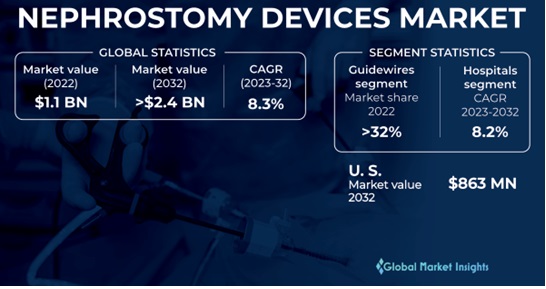Home > Healthcare > Medical Devices > Therapeutic Devices > Nephrostomy Devices Market
Nephrostomy Devices Market Size
- Report ID: GMI4325
- Published Date: May 2023
- Report Format: PDF
Nephrostomy Devices Market Size
Nephrostomy Devices Market size was valued at around USD 1.1 billion in 2022 and is anticipated to grow at a CAGR of over 8.3% between 2023 and 2032.This incremental growth rate is owing to increasing prevalence of kidney disorders coupled with rising demand for minimally invasive surgeries.
Technological advancements pertaining to nephrostomy devices in the diagnosis and treatment of several chronic ailments including bladder, ovarian, and prostate cancers is expected to augment the market growth in the forecasted timeframe. Rising healthcare spending for providing better healthcare infrastructure, increasing disposable income and consistently increasing geriatric population are some of the major factors responsible for increased adoption of nephrostomy devices across the world.
A nephrostomy device is a medical device used to drain urine from the kidney through a tube that is inserted through the skin and into the kidney. These devices are intended to remove an obstruction in the urinary tract, such as a kidney stone or tumor, that is preventing urine from flowing properly.
| Report Attribute | Details |
|---|---|
| Base Year: | 2022 |
| Nephrostomy Devices Market Size in 2022: | USD 1.1 Billion |
| Forecast Period: | 2023 to 2032 |
| Forecast Period 2023 to 2032 CAGR: | 8.3% |
| 2032 Value Projection: | USD 2.4 Billion |
| Historical Data for: | 2018 to 2022 |
| No. of Pages: | 170 |
| Tables, Charts & Figures: | 295 |
| Segments covered: | Product, End-use, and Region |
| Growth Drivers: |
|
| Pitfalls & Challenges: |
|
However, availability of substitute procedures for nephrostomy can act as a significant barriers and thereby impede the nephrostomy devices market growth in the coming years. There are several alternative procedures that may be used instead of a nephrostomy, depending on the specific medical condition and individual circumstances of the patient. This procedure is majorly used to treat kidney stones, tumors, or other obstructions in the urinary tract.

